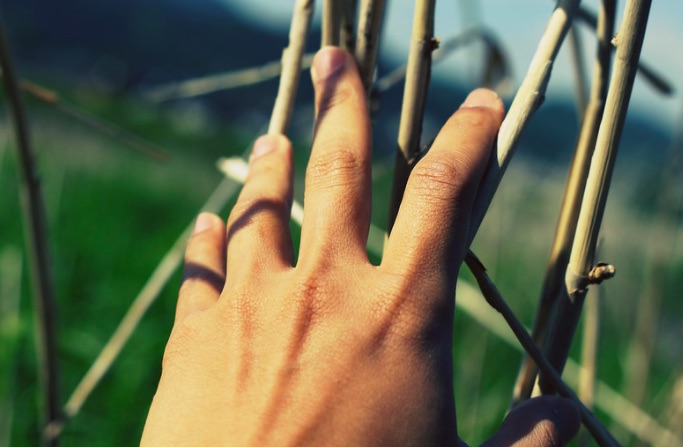As a teenager, when I saw my mother talk to her leafy and beautiful home plants in El Salvador, I thought she was, well, crazy.
Interestingly, 30 years later or so, I am doing the same. In fact, I even took it a step further and became a Forest Therapy® guide. I guide others in partnership with the natural world, which, in this practice, is called the “more-than-human world.”
Now, we face new challenges in creating or maintaining a meaningful connection with nature while in quarantine—fears or restrictions might be keeping us from enjoying our favorite places outdoors.
Yet one of the best things we can do to support our health and well-being in this time of quarantine is connect to nature.
What is Forest Therapy anyway, and how does it work?
The practice of Forest Therapy invites you to consider that there is a world of trees and earth out there that can support you and your healing, especially during stressful times. I didn’t discover this; the Japanese did. They have scientifically proven that the relaxing and healing effects of the forest are not only subjective, but that “Forest Therapy” (also known as “Forest Bathing”) goes even deeper: drawing from the beneficial effects of immersion in forests and other natural areas can improve physical and mental well-being.
Forest Bathing began in Japan in the 1980s in response to a culture of extreme stress and overwork (sound familiar?). The practice, which involves slowing down, focusing on your senses, and spending time in a forest area or natural environment, has been so successful that, as of this writing, there are 62 certified forests across the country and more being planned.
The Forest Therapy Society of Japan notes several scientifically proven health benefits of Forest Therapy:
>> Reduces cortisol levels (stress-related hormones)
>> Calms your nervous system
>> Lowers your heart rate
>> Relieves tension and improves mood
>> Boosts the immune system and increases the count of the body’s Natural Killer (NK) cells—these are your cancer and tumor-fighting white blood cells
>> Increases the production of anticancer protein
One of the theories behind these benefits is that placing ourselves in a gentle, natural environment versus our modern, urban, artificial, and stressful one, more accurately reflects our lives as human beings across evolution.
So, historically speaking, Forest Bathing is familiar and relaxing to us.
Similar to the current research on mindfulness and compassion-based practices, the healing benefits of Forest Therapy are dose dependent, which means that the more we practice, the more we reap the benefits.
A formal Forest Therapy walk is usually guided by a professional and lasts at least a couple of hours. The aspiration of a walk is to slow down, letting our senses take precedence, so we can enjoy the aliveness of the natural world that is freely available to us.
You might be saying to yourself, “That sounds great, but what about if I don’t have access to a forest or natural area, especially now in quarantine? Can I still get those benefits?” Yes! Research shows that even “fake nature” (i.e., looking at a photograph of a natural environment) can have positive health benefits. So, by gazing or communing with that plant in your living room or by looking out at a vista of trees from your window, you can lower your stress and even improve your attention.
One downside of the quarantine is that some of us are isolated and touch-deprived. Touch, according to experts, is the first sense we develop as humans, so being touch-deprived can have negative effects on our health and well-being. However, it is possible to stimulate the pressure receptors under our skin by touching and feeling things in our natural environment that have texture, like the trunk of a tree or a plant (think moss!), a pet, of course, or even a nice, smooth rock.
Ready to give Forest Therapy a try? Below are some “invitations” that you can practice on your own in your house or your yard if you don’t have access to an outdoor setting, for whatever reason. They are called invitations because they are suggestions of things to do while in nature, but ultimately you need to follow your intuition and decide what feels good to you.
Before you begin your Forest Therapy experience, whether you’re inside or outside, consider turning your phone off or at least on airplane mode. (You might have to resist the urge to take pictures!) Think of this time as a technology break. You know you need this.
Next, if you plan to go outdoors for your walk, find a lovely place in nature. If you cannot leave home, you can be in your backyard or, if you don’t have access to a green area, you can stand inside near a home plant or look at a vista of trees from your window or balcony. And if none of this is possible, you may look at a photograph of a beautiful natural environment, or use the power of your imagination.
You can support the body and mind by listening to nature sounds of various kinds—the sound of a water fountain, for instance. Smelling some essential oils made from coniferous trees can be of benefit too. Also, you can invite some elements of nature inside your home, just like my five-year-old does on her walks. She has learned to ask the being she is planning to bring home for permission, such as a pine cone or a pretty leaf.
Trust that if you ask the question, and you are really quiet, you will hear the response.
Now you are ready—enjoy these invitations!
1. Sensory Invitation (10 minutes)
Look around and notice where you are. Close your eyes or soften your gaze (if that is comfortable). Notice your breath and the quality of breathing. Turn your attention to the ground where you are standing or sitting, and feel your body and its connection to the earth. What can you feel on your skin or through the sense of touch?
Can you hear some sounds around you? If so, what are they? Are they near or far?
Perhaps take some deep breaths. Can you notice the scents around you? Can you taste something in your mouth? After doing this once more, look around, paying attention to what it feels like to be where you are.
What are you noticing?
2. Sensory Walk (10 minutes)
Walk slowly and silently (if possible, continue to do this outdoors), noticing “what is moving” around you. If you are called to, you are free to touch and smell. Trusting your intuition and your curiosity to guide you, notice what is in motion. And if you think you don’t see anything, I invite you to look closer.
What are you noticing?
If you are indoors, a home plant or a pet can be wonderful to engage with, smelling and touching as if you have never done it before. Or you may look at a tree through the window. The possibilities are unlimited.
3. Choose Your Invitation (10 minutes)
The suggestion is to do any of these two invitations for a minimum of 10 minutes:
a) Find somewhere to lie down and look at the clouds in the sky. Imagine what it would be like if your worries were like the clouds in the sky. Perhaps you might let the wind carry a worry away.
b) If there is a breeze, take a minute and feel it on your body. Consider what messages might be coming in the wind. Perhaps send a message out on the wind.
4. Sit Spot (10 minutes or more)
Find a place where you feel comfortable and at ease, and where you can be in silence for at least 10 to 15 minutes. The invitation, in the words of Mary Oliver, is to “let the soft animal of your body love what it loves.”
In other words, practice just being, taking everything in. Know that if you are in the hands of the more-than-human world, you are in good hands.
~
Curious what it’s like to be guided on a walk? Consider taking one of my Forest Therapy® walks via Zoom Video Conferencing. For more information, visit my website.
~












Read 0 comments and reply